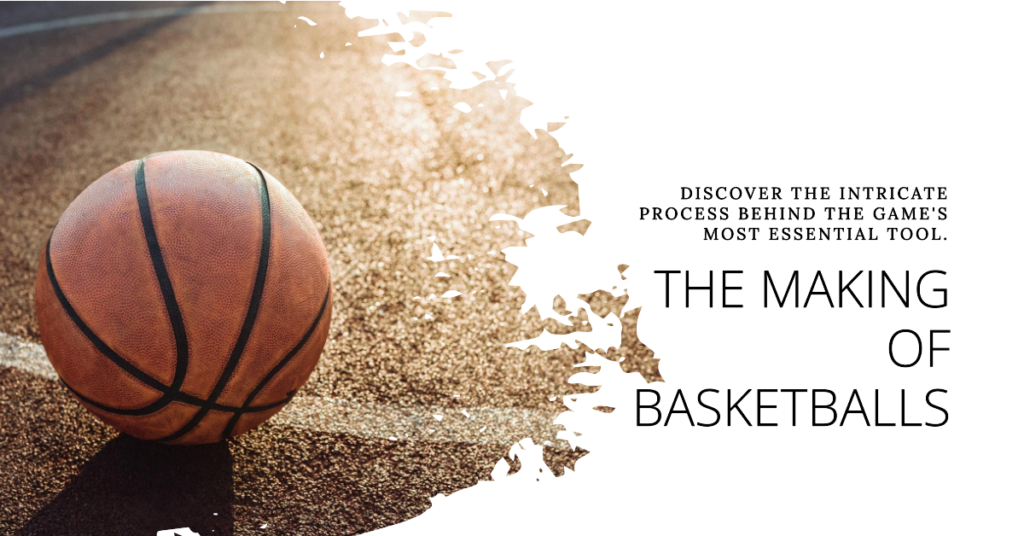Basketballs are made by curing rubber, stitching panels, and inflating the ball. Basketballs start their manufacturing journey by curing rubber, which provides the ball’s resilience and bounciness.
Once the rubber is ready, it is cut into panels, forming the ball’s outer shell. These panels are stitched together using a unique technique to create a durable and seamless surface. Lastly, the ball is inflated to the desired pressure, ready for use on the court.
The production of basketballs involves precision and attention to detail to ensure the ball meets the required standards for the game. We will delve deeper into the manufacturing process of basketballs, providing insights into the materials used and the techniques employed. Additionally, we will explore how innovations have improved the quality and performance of basketballs over time.
The Raw Materials: From Rubber To Leather
Basketballs are made with various raw materials, including rubber and leather. These materials undergo specific manufacturing processes to create the final product.
Basketballs are essential in basketball, but have you ever wondered how they are made? From the raw materials to the finished product, each step in the manufacturing process is crucial in creating a high-quality basketball.
In this blog post, we will explore the journey of basketball production, focusing on the role of rubber and leather in the process.
The Role Of Rubber In Basketball Production:
- Natural rubber is the primary material used in basketball manufacturing due to its flexibility and durability.
- Rubber serves as the main component for the outer covering, also known as the basketball’s “skin.”
- Using rubber ensures the ball can withstand the intense dribbling, bouncing, and handling during gameplay.
- Rubber also provides excellent grip, allowing players to control the ball better.
The Transformation Of Rubber Into Basketball Components:
- Rubber is initially harvested from rubber trees in tropical regions and extracted from the tree’s bark in a process called tapping.
- The sticky white substance from the bark is processed to remove impurities and create high-quality rubber sheets.
- These rubber sheets are then cut into individual panels, typically six or eight, forming the basketball’s outer layer.
- The panels are carefully molded using specific machinery to ensure uniformity and precision in shape.
- Once the panels are molded, they are combined using specialized adhesive techniques to create the final basketball shell.
Exploring The Uses Of Leather In Basketball Manufacturing:
- Leather is often used for the basketball’s inner lining, providing a soft and comfortable feel during gameplay.
- Genuine leather, commonly sourced from cowhide, is preferred due to its durability and natural properties.
- The leather undergoes various processes, including tanning and finishing, to enhance strength and suppleness.
- The tanned leather is cut into patterns to fit the basketball’s inner structure.
- The seams of the leather pieces are carefully stitched together, securing the inner lining to the outer rubber shell.
By understanding the role of rubber and leather in basketball manufacturing, we gain a deeper appreciation for the craftsmanship behind these essential sports equipment. The combination of rubber’s durability and grip, along with the supple comfort of leather, creates the perfect balance for an enjoyable basketball-playing experience.
Whether you’re a professional athlete or a casual player, the quality of the materials used in basketball production significantly impacts the game.
The Manufacturing Process: Turning Materials Into Basketballs
Basketballs are made through a detailed manufacturing process that transforms materials into the final product. This process involves precise steps and techniques to ensure the production of high-quality basketballs.
Basketball is not just a game; it’s a symbol of athletic excellence and perseverance. But have you ever wondered how these iconic spheres are made? We’ll dive into the intriguing manufacturing process of basketballs, uncovering the steps that turn raw materials into the beloved sports equipment we know and love.
Preparing The Rubber And Leather For Production:
- The rubber used in basketballs is prepared by mixing natural and synthetic rubber compounds. This combination ensures a durable and high-performing material.
- The rubber mixture is then molded into a spherical shape using precision machinery, creating the outer shell of the basketball.
- On the other hand, leather, the traditional material used, undergoes a thorough cleaning and refinement process. This removes any impurities and ensures a smooth and flawless texture.
- Once ready, the leather is carefully cut into panels that will be stitched together to form the basketball’s outer cover.
- The rubber shell and leather panels are now ready for the subsequent stages of production.
Building The Inner Core: From Bladders To Layers:
- The first step in building the inner core is inserting a bladder into the rubber shell. The bladder is typically made from latex and is the foundation of the basketball’s shape and bounce.
- After the bladder is secured within the rubber shell, additional delicate layers of rubber or synthetic materials are added. These layers enhance the ball’s durability while contributing to its bounce and feel during play.
- Each layer is meticulously applied, ensuring a precise thickness and distribution of materials. This process is crucial to achieve the desired performance characteristics of the basketball.
- Once all the layers are in place, the ball undergoes a curing process, during which it is heated and compressed. This step allows the materials to bond and strengthen, enhancing the ball’s durability and performance.
The Assembly Line: Putting The Basketball Together:
- It’s time to bring the basketball together with the outer cover and inner core prepared. The assembly process primarily involves stitching the leather panels onto the rubber shell.
- Skilled artisans carefully align and stitch each panel to form a tight and secure connection. Attention to detail is paramount to ensure a smooth surface without visible seams.
- Once the panels are stitched together, the basketball undergoes a thorough inspection for quality assurance. Any imperfections or inconsistencies are addressed at this stage.
- The basketball is given its signature shape through inflation to complete the process. The bladder is filled with pressurized air, allowing the ball to reach its optimal size and bounce.
- After passing quality checks, the finished basketballs are prepped and packaged, ready to be distributed to athletes and enthusiasts worldwide.
And there you have it—the fascinating journey of turning raw materials into the basketballs that bring joy and excitement to the game. The meticulous craftsmanship and attention to detail ensure that every basketball rolling on the court is a testament to the tireless efforts behind its creation.
Quality Control: Ensuring Perfection In Every Basketball
Basketballs undergo a meticulous quality control process to ensure excellence in their make. From the materials used to the precision in stitching, every detail is scrutinized to create the perfect basketball.
Basketballs are an essential game component, providing players with the perfect tool to dribble, shoot, and score. But have you ever wondered how these balls are made? In this blog post, we will delve into the intricate process of manufacturing basketballs, focusing on the paramount aspect of quality control.
Testing the ball’s Bounce And Grip
To ensure optimal performance on the court, every basketball goes through rigorous testing procedures. Here are the key elements that are scrutinized during quality control:
- Bounce: A basketball’s bounce is crucial for playability. Skilled technicians measure the rebound height by dropping the ball from a standardized size and assessing its response. It must bounce to the specified heights, ensuring consistency and fairness across all games.
- Grip: A solid grip on the basketball gives players better control and minimizes the chance of slipping. Testing involves evaluating the texture, pattern, and material used for the outer surface of the ball to guarantee optimum grip for all players.
Inspecting For Defects And Imperfections
Basketballs undergo meticulous inspections to identify any defects or imperfections hindering their performance. Here are the aspects examined during the inspection process:
- Seams: Inspectors meticulously evaluate the basketball seams to ensure they are securely stitched. Any loose or uneven seams can affect the ball’s flight and durability, thus compromising its overall quality.
- Surface Quality: The surface of a basketball must be smooth and free from irregularities. Inspectors scrutinize for any scratches, nicks, or inconsistencies on the ball’s outer shell, as they can impact shooting accuracy and overall feel.
- Weight: Each basketball’s weight is checked to ensure it falls within the predetermined range. This guarantees that players will have a consistent feel and experience during games, enabling them to make accurate shots and passes.
Balancing Consistency And Variance In Production
Manufacturing basketballs requires striking a delicate balance between consistency and variance. Here’s how this balance is achieved:
- Uniform Specifications: Every basketball is manufactured according to standardized specifications regarding size, weight, and materials used. These specifications ensure uniformity across all balls produced, providing a level playing field for players worldwide.
- Natural Variations: Despite the pursuit of consistency, some natural variations may arise during production. While these variations are minimal, they contribute to each basketball’s unique characteristics, making them feel distinct in players’ hands.
- Continuous Quality Control: Quality control measures are implemented throughout manufacturing to identify deviations from the desired standards. This ensures that only the highest quality basketballs are released for use, meeting the expectations of professionals and recreational players.
By upholding stringent quality control measures, basketball manufacturers can guarantee that each basketball possesses the perfect bounce, grip, and durability balance. So, the next time you shoot hoops, you can have confidence in the precise craftsmanship that goes into every basketball.
Understanding The Art Of Manufacturing: Skills And Expertise
Manufacturing basketballs requires a unique skill set and expertise. This article delves into the art of making basketballs, exploring the process and techniques behind their production.
Basketball is a game loved and played by millions of people worldwide. Have you ever wondered where iconic spheres of athletic prowess are made? This blog post will delve into the fascinating world of basketball manufacturing, exploring the skills, expertise, and craftsmanship involved in creating these sporting essentials.
Get ready to uncover the art behind the production of basketballs.
The Role Of Craftsmanship In Basketball Production:
- Craftsmanship is crucial in the production of basketballs as it ensures the highest quality and performance. Here’s how it comes into play:
- Hand-stitching precision: Each basketball undergoes meticulous hand-stitching to ensure durability and optimal bounce. Skilled artisans stitch the panels together, creating a seamless and balanced ball.
- Attention to detail: Craftsmanship is vital in checking for imperfections or inconsistencies in manufacturing. From the placement of the panels to the precision of the stitching, every detail matters to create a superior basketball.
- Quality control: Craftsmen conduct rigorous quality checks to guarantee that every basketball meets the highest standards. They inspect the ball’s weight, size, and overall construction, ensuring it meets professional play requirements.
Training And Development Of Skilled Workers:
- Skilled workers play a vital role in basketball production. Here’s how training and development contribute to their expertise:
- Specialized training: Skilled workers undergo comprehensive training programs that focus on the art of basketball manufacturing. They learn the intricate techniques of stitching, cutting, and shaping the panels, developing a keen eye for detail.
- Experience-based skills: Through years of practice and hands-on experience, skilled workers refine their techniques and become masters of their craft. Their expertise allows them to create basketballs that offer optimum performance on the court.
The Intersection Of Technology And Traditional Manufacturing Techniques:
- The manufacturing of basketballs combines traditional techniques with technological advancements. Here’s how this intersection enhances the production process:
- Enhanced precision: Technology aids artisans by providing advanced artisans and equipment for improved accuracy in cutting the panels and stitching. This ensures consistent quality across batches of basketballs.
- Material innovation: Technological advancements allow for the development of innovative materials to improve the performance and durability of basketballs. Synthetic materials and composite leather are now widely used, providing a superior grip and feel.
- Testing and analysis: Technology enables manufacturers to conduct rigorous testing and research of basketballs, ensuring that they meet the standards for bounce, weight, and circumference. This data-driven approach enhances the overall quality and performance of the final product.
The production of basketballs is an art that combines the skills of artisans, the training and development of skilled workers, and the integration of technology with traditional manufacturing techniques. The dedication and expertise that go into creating these sporting gems result in basketballs that deliver exceptional performance and withstand the demands of the game.
So, the next time you hit the court, remember the craftsmanship and expertise behind the basketball in your hands.
Behind The Scenes Of Production: The Journey Of A Basketball
Discover the fascinating journey of a basketball from the production line to the court as this article unveils the intricate process behind making this iconic sports equipment. Explore the precision and craftsmanship involved in creating basketballs, providing insights into the fascinating world of sports manufacturing.
Basketball is one of the most popular sports in the world, and while we may take it for granted, have you ever wondered how those basketballs are made? In this blog post, we will take a closer look at the behind-the-scenes journey of a basketball, exploring basketball factories, the supply chain and logistics involved in manufacturing, and the sustainability initiatives in basketball production.
Exploring Basketball Factories Around The World
- Raw Materials: High-quality basketballs start with selecting top-notch raw materials, such as synthetic leather or composite leather, carefully chosen for their durability and performance.
- Cutting and Stitching: The raw materials are then cut into panels that form the outer shell of the basketball. These panels are stitched together with precision to create the iconic spherical shape.
- Bladder Insertion: A rubber bladder is inserted into the basketball to provide its bounce angle, stated and secured tightly to maintain proper pressure and ensure consistent performance.
- Testing and Quality Control: Each basketball goes through rigorous testing to ensure it meets quality standards. It undergoes inspections, weight measurements, and bounce tests to ensure consistent manufacturing quality.
Supply Chain And Logistics In Basketball Manufacturing
- Sourcing: Basketball manufacturers collaborate with suppliers to source the necessary raw materials. These suppliers must meet strict quality standards to ensure the final product’s performance and durability.
- Production Planning: A detailed production plan specifies the quantity of basketballs to be manufactured, the materials required, and the timeline for each step of the production process.
- Manufacturing Facilities: Specialized basketball factories have state-of-the-art machinery and skilled workers who meticulously assemble the basketballs. Each factory follows standardized processes to maintain consistency and quality.
- Packaging and Distribution: Once the basketballs are manufactured, they go through packaging processes, including boxing and labeling. They are then transported to distribution centers and retailers worldwide, ready for enthusiasts to enjoy.
Sustainability Initiatives In Basketball Production
- Material Choices: Basketball manufacturers increasingly focus on sustainable materials, such as recycled materials and eco-friendly synthetic alternatives. By prioritizing sustainability in material choices, they reduce their environmental impact.
- Energy Efficiency: Many basketball factories implement energy-efficient technologies and practices to minimize their carbon footprint. This includes using renewable energy sources, optimizing machinery efficiency, and implementing energy-saving measures.
- Waste Reduction and Recycling: Waste management programs are implemented to reduce waste generation during manufacturing. Recycling initiatives are also encouraged to ensure that reusable materials are appropriately utilized.
- Ethical Laappropriatelytices: Basketball manufacturers are mindful of their social responsibility and emphasize fair labor practices. This includes providing safe working conditions, fair wages, and promoting employee well-being.
As you can see, the production of basketballs involves a multi-step process that requires careful attention to detail and consideration for sustainability and ethical practices. From the selection of raw materials to the distribution of the final product, each stage plays an essential role in ensuring that vital ball enthusiasts worldwide can enjoy the sport they love.
Frequently Asked Questions On How Basketballs Are Made
How Are NBA Balls Made?
The NBA balls are made through synthetic materials and specific manufacturing techniques.
What Materials Are Used To Make Basketballs?
Basketballs are made using materials such as synthetic leather, rubber, and various layers of fabric.
Why Did the NBA Stop Using Spalding?
The NBA stopped using Spalding because they switched to Wilson as their official basketball supplier.
Are NBA basketballs Made Of Rubber?
Yes, NBA basketballs are made of rubber.
Final Words
Understanding how basketballs are made allows us to appreciate the craftsmanship and attention to detail that goes into creating these iconic sports equipment. From selecting materials, including premium or synthetic leather, to the intricate stitching and molding processes, every step is crucial in ensuring a high-quality basketball that provides optimal performance on the court.
The use of advanced manufacturing techniques and technology has revolutionized the production of basketballs, resulting in improved durability and bounce. Whether you’re a professional athlete or a casual player, knowing the effort that goes into making a basketball can enhance your game experience.
So, the next time you pick up a basketball, take a moment to appreciate the artistry and skill behind its creation. With the right combination of materials and craftsmanship, basketballs continue to evolve, ensuring players can enjoy the sport for years.
Considering taking your basketball knowledge to the next level, consider exploring ‘How to Improve Basketball IQ‘ to enhance your understanding of game strategy and tactics.






